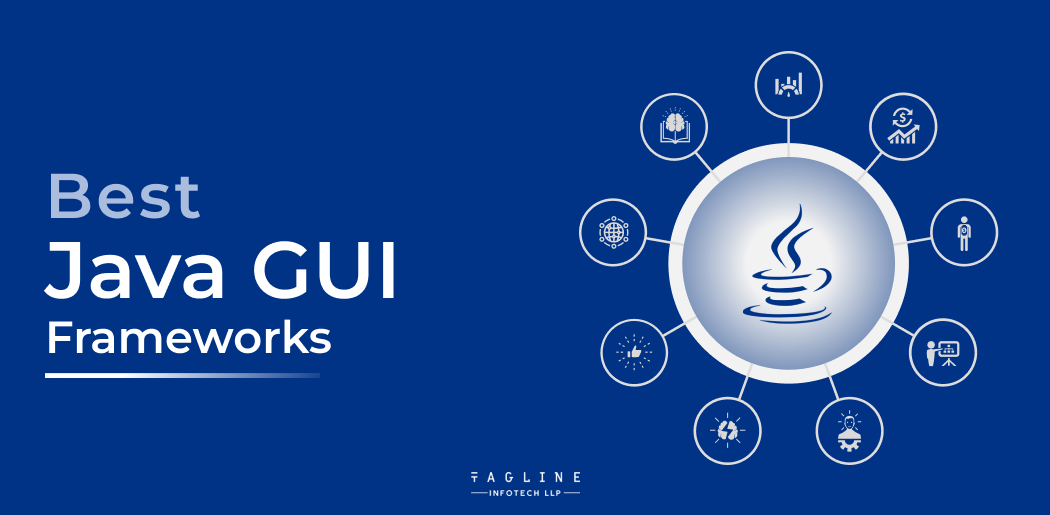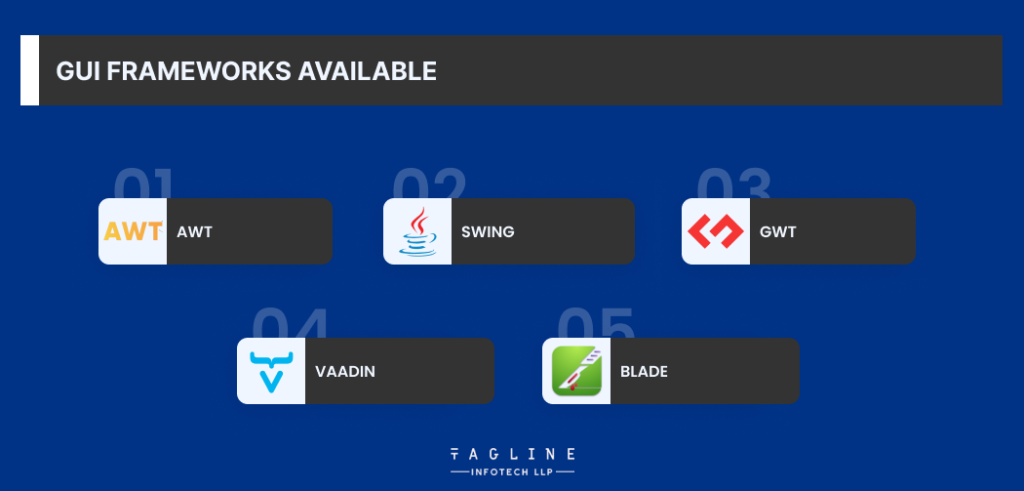How ChatGPT and RPA are Transforming Automation’s Future
May 17, 2024
Home >> Java >> Best Java GUI Frameworks

Introduction
A skilled development team can create every element required to make an application work and be profitable for your company or the wider public. The same team may have created a top-notch application with an excellent graphical user interface (GUI) that works for any user or use case.
However, why would you want them in charge of creating every single part of that application? Think of it like this: What if your business produced cars? You have two options: either build the necessary equipment and tools to make every part of that car or hire a company specializing in producing smaller parts like tires, pipes, wires, mirrors, windshields, servos, and mirrors. This would not only lower the cost of your car, but it would also significantly increase the production process’s dependability and efficiency. This is where graphical user interface frameworks may be helpful in your development process.
But improving items’ efficiency and lowering costs isn’t the only objective. The code in Java GUI Frameworks has undergone extensive testing and examination. There are no surprises in the frameworks because the Java code that comes with them works precisely as expected. As a result, you’ll save even more money by debugging for a shorter amount of time and money. You’ll be able to release your Java programs more quickly, and users of your apps will have fewer issues.
Thus, this might significantly contribute to building your brand’s reputation as a reliable one. When consumers can rely on your goods, word-of-mouth will grow, and you’ll find that your company’s reputation is growing exponentially. Not only that but using the best Java frameworks also makes it easier for your teams to provide a product they are proud of, which will boost their confidence all along the way. Everything will go more quickly. Your teams can iterate on each new project faster and more reliably.
Every company will have different factors to consider when selecting a Java graphical user interface framework that enables the development of sophisticated components. Depending on the sector you work in, it is advised that one or more of the following subjects be addressed during the early stages of product development:
The kinds of applications you are developing are hybrid apps that will work on several platforms: Internet of Things, desktop, Android, and web apps. Before choosing your graphical user interface framework, this needs to be one of your top priorities. In actuality, needs for mobile applications differ from those for web applications, and so forth.
What operating systems will your developers use, and are the frameworks you consider compatible with any or all of those platforms?
Does your current project require the use of open-source frameworks to be completed? Is it lawful for you to publish your Java programs under a license known as a proprietary license and use the open-source framework in addition to your closed-source code?
Will interacting with one or more public APIs be necessary for your application? If so, you must confirm that your framework can communicate with the API (if required).
Will RESTful APIs be necessary for your application to access and use data? If not, is it feasible to utilize HTTP requests in their place? In such a scenario, you must choose a framework that works with RESTful APIs.
“How to Updatе Java: A Stеp-by-Stеp Guidе (2024) “
– Also Read Article

Here is the list of GUI frameworks available
It is the core of Swing, and although it performs well, it lacks certain more intricate elements. AWT is often only one of the best options to create handy apps. However, this might be a perfect suit for smaller graphical user interface apps that don’t need large user interfaces because it is a tried and tested framework.
According to AWT, as was previously stated. It was thought to be slow and prone to problems in its early phases, so IBM created the SWT for Eclipse. However, Swing became the go-to framework for creating new applications after the release of Java 5 (or 6?). Swing has many rich elements, yet there are still some areas where it falls short.
The Google Web Toolkit (GWT) is a free and open-source framework. Its purpose is to help developers write client-side Java code and set it up as JavaScript. GWT is used in writing a large variety of Google products, such as AdSense, Google Wallet, and Blogger.
By employing GWT, developers may create complex online applications easily and rapidly. This plugin can also design and debug Ajax applications in Java. With GWT, you don’t have to be an expert in front-end technologies like responsive design or JavaScript optimization to build robust browser-based applications.
Vaadin is an online application framework that prioritizes accessibility for the user experience. You are given access to a platform that makes it easier to create Java. You can also create web applications with Vaadin by utilizing customizable components.
Vaadin 10 takes a new approach to web application development. You will access the Document Object Model (DOM) directly through the Java Virtual Machine. The Vaadin team separated the previous framework into two portions with the release of the updated version. It also comes with Vaadin Flow, a lightweight Java framework that manages communication and routing between clients and servers.
This Java framework’s goal is to offer a full-stack web framework. It’s a simple, lightweight, and efficient structure. Blade is a lightweight MVC Framework that aids data synchronization with the website and facilitates a relaxing routing interface. As a result, the web application programming interface (API) is easier to understand and cleaner.
Furthermore, Blade is built upon the Java 8 foundation, including the template engine and web server. Its small impression suggests that the total size of the source code is less than 500 kilobytes.
Optimize your Java applications with leading top-tier GUI frameworks!
Hire a Java developer to harness the power of the best in Java GUI development now!

Many modern computer languages and older desktop operating systems, including MS-DOS, use command-line interfaces. You must type many code lines at a command line to use these interfaces and access the system’s features. It is necessary for you to be knowledgeable about the commands that are accessible on the system and to know how to enter them correctly. This is why even minor mistakes, like misspellings or incorrect spacing, make it impossible to perform a function.
GUI represents those lines of command that are now hidden using graphic elements. All you have to do is choose a button or an icon to invoke the relevant function. Because graphical user interfaces (GUIs) are so easy to use, the general public may now access various systems for daily usage regardless of expertise or knowledge level.
Employing a graphical user interface (GUI) offers numerous other benefits. Here are a handful of the more typical ones:
Users find identifying, classifying, and navigating through the various options easy because symbols, shapes, and icons represent data. A single click is all it takes to acquire a function. Because of its ease of use and comprehension, the graphical user interface (GUI) has become the most widely used option for user interfaces on computers and mobile devices.
The graphical user interface (GUI) has visually appealing elements and is free of command line codes. Long lines of computer code can express emotions, remarks, and situations in visual representations. Visual media, such as images, can convey a universal importance and are easily understood.
Data representations in text are recognized faster than those in visual form. Even people who are not programmers can easily use graphical user interfaces because they don’t require any prior understanding of computational techniques. They don’t have to worry about writing code or repairing errors. The graphical user interface (GUI) is considered an intuitive interface by users.
By using shortcut keys, users can restrict the amount of strokes they make. Users can increase their productivity and save time by utilizing a pair of keys to do many activities. For example, a button that asks visitors to do anything might open a form, an already-completed letter, or a list of contacts. You won’t have to look for the same information using that button.
Users can show and work multiple applications simultaneously with graphical user interfaces. As an illustration, consider the ability to search the internet and watch a streaming presentation on the same web browser. It is possible to use a search engine in a separate tab to write a review of the presentation while watching a video.
Whether your Java development team is in-house or outsourced, choosing the proper Java GUI frameworks will save them a ton of time and effort and help you create robust graphical user interfaces. Maybe you should get in touch a Java development company who can use best GUI Java framework to deliver amazing solutions. Because they may reuse and include code from several libraries, you will save time and money by reducing the need for debugging. This is because they can only start from scratch sometimes.
When choosing the best Java GUI framework for your project, it’s critical to ensure your development teams know Java best practices to get the most out of the language and framework.
Yes, you can use different types of Java-based GUI frameworks like AWT, Swing, GWT, Vaadin, Blade, and many more in a project to create some of the most amazing user interfaces.
The developers can use a Swing GUI Java framework to create a class and different types of classes that work as a container where all the other components will be stored to be displayed on the main screen.

Digital Valley, 423, Apple Square, beside Lajamni Chowk, Mota Varachha, Surat, Gujarat 394101
+91 9913 808 2851133 Sampley Ln Leander, Texas, 78641
52 Godalming Avenue, wallington, London - SM6 8NW